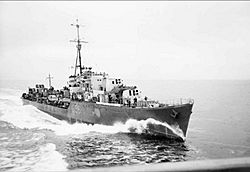Battle of the Campobasso Convoy facts for kids
Quick facts for kids Battle of the Campobasso Convoy |
|||||||
|---|---|---|---|---|---|---|---|
| Part of the Battle of the Mediterranean of World War II | |||||||
 HMS Petard photographed from HMS Formidable, December 1943 |
|||||||
|
|||||||
| Belligerents | |||||||
| Commanders and leaders | |||||||
| Strength | |||||||
| 3 destroyers | 1 torpedo boat 1 merchantman |
||||||
| Casualties and losses | |||||||
| No casualties | 76 men killed (Italian merchant navy) 133 men killed (Italian Navy): Total: 209 103 men rescued 1 torpedo boat sunk 1 merchantman sunk |
||||||
The Battle of the Campobasso Convoy was a sea fight during World War II. It happened near Cape Bon in the Mediterranean Sea on the night of May 3-4, 1943. Three British Royal Navy destroyers fought an Italian torpedo boat. The Italian ship was protecting a large cargo ship called Campobasso. This cargo ship was heading to Tunisia.
Contents
Why This Battle Happened
Towards the end of the North Africa campaign, two British destroyers, HMS Paladin and HMS Nubian, were patrolling near Cape Bon. On April 29-30, they sailed along the south coast of Sicily. There, they found a German cargo ship called Fauna with German E-boats protecting it. The British destroyers sank Fauna without any losses to themselves.
Getting Ready for Battle
A few days later, the British got secret information. They sent Nubian, Paladin, and HMS Petard to wait for an Italian convoy.
The Italian cargo ship Campobasso left Pantelleria island at 7:00 PM on May 3. It was carrying bombs, land-mines, trucks, and other supplies for the Axis forces in Tunisia. Soon after leaving, the Italian torpedo boat Italian torpedo boat Perseo, led by Saverio Marotta, joined it as an escort.
The two Italian ships sailed carefully through areas with both Axis and Allied minefields. On the night of May 3-4, near Kelibia on the Cap Bon peninsula, the British destroyers detected the Italian ships on their radar. The Perseo had a special detector that picked up the British radar signals. It quickly sent a warning to Supermarina, the Italian Navy headquarters.
The Fight Begins
At 11:35 PM, bright star shells burst over the Italian ships. They were about 7 nmi (13 km) east of Kelibia. The Campobasso was hit almost immediately and caught fire.
A crew member on Perseo later wrote about that night. He said everyone knew what would happen next. The torpedo boat quickly turned towards the enemy to fire its torpedoes.
The Perseo launched its two torpedoes from about 700 yd (640 m) away. Then it sped away to the north-west towards Cape Bon. The Campobasso exploded at 11:48 PM, lighting up the Perseo.
The British ships fired more star shells. The Perseo started making sharp turns to avoid hits. But at 11:52 PM, its steering system broke. Before the crew could steer it by hand, the ship was hit by two shells. More shells hit the bridge and the engine rooms. Steam filled the deck as the engines stopped working.
The British destroyers came very close, within 500 yd (460 m). They fired their main guns and anti-aircraft weapons. At 11:58 PM, Commander Marotta ordered his crew to leave the ship. The Perseo stayed afloat for about an hour. Then its ammunition storage exploded, and the ship sank at 1:00 AM.
After the Battle
The next day, an Italian hospital ship called Principessa Giovanna rescued four survivors from Campobasso. Twenty other men from Campobasso reached the coast in a lifeboat. The hospital ship also rescued 67 men from Perseo. On May 6, the hospital ship was bombed by Allied aircraft. This attack killed 54 men and wounded 52.
Who Was Lost
The Campobasso had 93 crew members, and 73 of them died. The Perseo had 133 deaths, but 83 men were rescued. Commander Marotta was among those who died.
Other Operations
Another Italian convoy, led by the Ciclone-class torpedo boat Tifone, carried aviation fuel. It was escorting the cargo ship Belluno to Tunis from Trapani. This convoy managed to avoid the British destroyers after seeing the Campobasso destroyed. The Tifone convoy arrived on May 4. This was the last Axis supply run to reach Africa during the war.
Another Italian convoy sailed on May 4. It included the Italian lighter MZ 724 and the water supply ship Scrivia. They evacuated 200 Italian troops from Bizerte. They reached Cagliari the next day without being detected.
Operation Retribution
As Axis airfields in Tunisia were captured, Allied fighter planes could protect Allied ships. This made it possible for ships to patrol during the day between Tunisia and Sicily. Allied convoys along the coast and to Malta were stopped. Their escort ships were sent to block Tunisia instead.
Allied planes were ordered to attack Axis ships within 5 nmi (9 km) of the Tunisian shore. Beyond that limit, Allied ships could move freely. British mines had been set to sink in early May. Information about Axis minefields was good enough to risk sailing in some areas.
From the night of May 8-9, Paladin, with HMS Jervis, Petard, and Nubian, shelled Kelibia on May 7 and 9. Other British ships from Force Q, including HMS Laforey, Loyal, Tartar, and ORP Błyskawica, maintained a blockade off Cape Bon during the day. They had to paint their ships' upper parts red to avoid being attacked by friendly aircraft. British Motor Gun Boats, Motor Torpedo Boats, and US PT boats patrolled closer to the shore at night.
The Allies had such a strong advantage that the Italian Navy decided it was useless to try to evacuate troops. Some attempts were made to escape Tunisia after May 7. Only the German KT 22, some Axis torpedo boats, and MAS boats managed to get through the blockade. By the time the Axis forces surrendered, the blockading ships had captured 800 prisoners.

